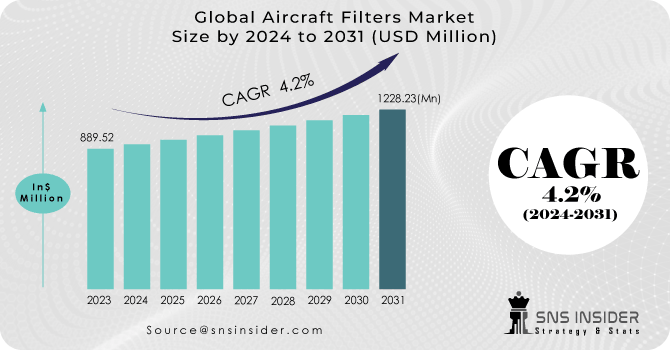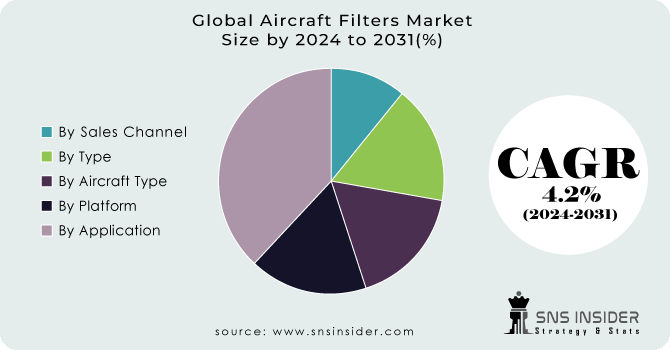Aircraft Filters Market Report Scope & Overview:
The Aircraft Filters Market Size was valued at USD 889.52 million in 2023 and is expected to reach USD 1228.23 million by 2031 and grow at a CAGR of 4.2% over the forecast period 2024-2031.
Aircraft filters prevent contamination, solid particles, and debris from aircraft engines, water systems, aircraft cylinders, living quarters, and other areas. Air filters play a very lucrative role in the efficiency and maintenance of aircraft. It helps to improve efficiency and effectiveness as well as provide fresh air to passengers. In addition, hydraulic fluids are used in aircraft systems to lubricate, build a power station and provide heat transfer mechanisms. Liquid filters play a vital role in removing contaminants from liquid liquids and fuels otherwise contaminants can cause systemic failure and increase repair costs. In addition, these filters are separated to filter out pollutants and debris from water systems, engines, cabinets, and avionics. Pollutants include subsumed metal flakes, ashes, glass, lint, rubber, various fibers, sand, and more. Pollution dramatically affects the performance and reliability of the aircraft component. In addition, there are sound filters that are designed to reduce engine noise and other components of the aircraft so that passengers can relax in the house. The role of an air filter is therefore to eliminate pollution in the system and to ensure that noise, fluid, and air are within the design tolerance.

To get more information on Aircraft Filters Market - Request Free Sample Report
MARKET DYNAMICS
KEY DRIVERS
-
The replacement cycle is short
-
High passenger traffic
RESTRAINTS
-
High cost
-
High maintenance
OPPORTUNITIES
-
Highest manufacturers in APAC & Latin America
-
Higher demand
CHALLENGES
-
Lower carbon emissions
-
Aircraft efficiency and proper airflow
THE IMPACT OF COVID-19
Governments in major countries have declared a state of emergency due to the COVID-19 pandemic, which has caused a halt in business. Since global air travel was halted due to the lockdown and travel restrictions, the aviation industry has suffered greatly. Furthermore, the lockdown disrupted aircraft manufacturing, affecting demand for aircraft filters. Furthermore, due to the lockdown, the delivery of already manufactured aircraft filters was delayed. Furthermore, due to social distancing norms, labour required for manufacturing aircraft filters was unavailable, further delaying the operation. Furthermore, there was a raw material shortage, which hampered the production of aircraft filters. The aviation industry is a developing sector that was severely harmed by the pandemic, but it is expected to recover and drive the industry forward. aircraft attitude indicators market post-pandemic.
by Type
The growth of the aircraft filters market's air filter segment can be attributed to two major factors.
Aircraft engine intake air supply These filters purify and remove debris, dust, and other contaminants from the intake air required by aircraft engines, whether reciprocating or jet engines.
cabin/aircraft fuselage. The filters inside the aircraft cabin are critical to the recirculation and filtering of air.
Passenger/crew cabin air supply is an artificially controlled supply of air that ensures the required levels of air pressure and air composition inside
by Sales Channel
The OEM segment is expected to grow at the fastest CAGR for the aircraft filters market during the forecast period, based on the sales channel. OEMs obtain aircraft filters from manufacturers. Airlines' fleet restructuring and expansion are expected to boost new aircraft sales, which will drive OEM demand for filters.
by Aircraft Type
The global aircraft market is divided into four categories: large widebody, medium widebody, small widebody, single-aisle, and regional jets. Because of their low cost, single aisle aircraft are expected to account for a relatively large market share of new deliveries and thus aircraft filters.
by Application
Hydraulic systems are used in a variety of applications, including flight control systems, lubrication, and cooling. The filters clean the fluid and keep unwanted debris out of the system. If the filter fails to remove such foreign particles, the aircraft will fail due to a single system malfunction. Because of rising demand for fuel-efficient aircraft, the engine segment has the potential to grow rapidly. The development of lightweight filters for overall aircraft weight reduction is also expected to support market growth.
by Platform
Military applications are expected to grow at a relatively high rate during the forecast period. In comparison to commercial and business aircraft, the replacement cycle of aircraft filters in military aircraft is shorter, which has resulted in significant growth of the military segment in the global market.
KEY MARKET SEGMENTATION
By Type
-
Fluid
-
Air and
-
Noise
By Sales Channel
-
OEM
-
Aftermarket
By Aircraft Type
-
Fixed Wing
-
Rotary Wing
-
UAV
By Application
-
Engine
-
Hydraulic System
-
Avionics
-
Cabin
-
Pneumatic system
By Platform
-
Commercial Aircraft
-
Business Jet
-
Military Aircraft

Need any customization research on Aircraft Filters Market - Enquiry Now
REGIONAL ANALYSIS
North America is expected to be the largest regional market share for aviation filters at the time of forecasting. The market is growing at an alarming rate in North America, with leading aircraft manufacturers, aircraft filters manufacturers, and distributors present in the region. Countries considered to analyze the market in the region are the US and Canada. The performance of raw materials, components, and assembly lines of aircraft filters are affected by the COVID-19 epidemic. Aviation systems, which include aircraft filters, are extremely important because of their use in the commercial and defense sectors.
The global aviation and business industry in North America is one of the most developed in the world. Further expansion of the sector and the growing demand for light aircraft and business jets are planned to expand the aviation filter market in the region. As the epidemic subsides and businesses and tourism return to normal levels, the North American aviation filter market is expected to grow slowly.
REGIONAL COVERAGE:
-
North America
-
USA
-
Canada
-
Mexico
-
-
Europe
-
Germany
-
UK
-
France
-
Italy
-
Spain
-
The Netherlands
-
Rest of Europe
-
-
Asia-Pacific
-
Japan
-
south Korea
-
China
-
India
-
Australia
-
Rest of Asia-Pacific
-
-
The Middle East & Africa
-
Israel
-
UAE
-
South Africa
-
Rest of Middle East & Africa
-
-
Latin America
-
Brazil
-
Argentina
-
Rest of Latin America
-
KEY PLAYERS
The Major Players are Safran Filtration Systems, Freudenberg Group, Porvair Plc, Purolator Facet Inc, Parker Hannifin Corporation, Donaldson Company Inc., Pall Corporation, Hollingsworth & Vose, Champion Aerospace LLC, Recco Products Inc, and other players.
Porvair Plc-Company Financial Analysis

| Report Attributes | Details |
|---|---|
| Market Size in 2023 | US$ 889.52 Million |
| Market Size by 2031 | US$ 1228.23 Million |
| CAGR | CAGR of 4.2% From 2024 to 2031 |
| Base Year | 2023 |
| Forecast Period | 2024-2031 |
| Historical Data | 2020-2022 |
| Report Scope & Coverage | Market Size, Segments Analysis, Competitive Landscape, Regional Analysis, DROC & SWOT Analysis, Forecast Outlook |
| Key Segments | • By Type (Fluid, Air and Noise) • By Sales Channel (OEM, Aftermarket) • By Aircraft Type (Fixed Wing, Rotary Wing, UAV) • By Application (Engine, Hydraulic System, Avionics, Cabin, Pneumatic system) • By Platform (Commercial Aircraft, Business Jet, and Military Aircraft) |
| Regional Analysis/Coverage | North America (USA, Canada, Mexico), Europe (Germany, UK, France, Italy, Spain, Netherlands, Rest of Europe), Asia-Pacific (Japan, South Korea, China, India, Australia, Rest of Asia-Pacific), The Middle East & Africa (Israel, UAE, South Africa, Rest of Middle East & Africa), Latin America (Brazil, Argentina, Rest of Latin America) |
| Company Profiles | Safran Filtration Systems, Freudenberg Group, Porvair Plc, Purolator Facet Inc, Parker Hannifin Corporation, Donaldson Company Inc., Pall Corporation, Hollingsworth & Vose, Champion Aerospace LLC, Recco Products Inc, and other players. |
| DRIVERS | • Replacement cycle is short • High passenger traffic |
| RESTRAINTS | • High cost • High maintenance |

